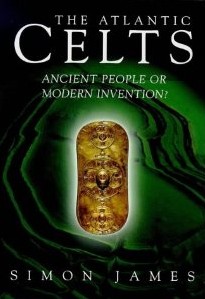The Atlantic Celts: Ancient People or Modern Invention? (1999) by Simon James
Rating: 




The theory presented by Simon James in The Atlantic Celts: Ancient People or Modern Invention? is that the pre-Roman inhabitants of the British Isles were not a single people united by language and culture, that had invaded, destroyed or assimilated earlier unrelated peoples, nor indeed were they ethnically related to the Celts in mainland Europe. Discoveries in Britain of ‘La Tene’ style artifacts prove only the existence of trading links or raids to and from Europe.
people united by language and culture, that had invaded, destroyed or assimilated earlier unrelated peoples, nor indeed were they ethnically related to the Celts in mainland Europe. Discoveries in Britain of ‘La Tene’ style artifacts prove only the existence of trading links or raids to and from Europe.
The term ‘Celt’ was used by the Greeks and Romans as a designation for some of their barbarian neighbours to the north. ‘Celt’ as applied to the Scots, Welsh and Irish was not used before the eighteenth century, and appears to be an explanation entirely dependent on similarities in language. The term was quickly developed by other scholars to describe cultural or national identities.
In his 1707 work Archaeologia Britannica , Oxford scholar Edward Lhuyd proposed that similarities in the Welsh, Breton, Cornish, Irish, and Scots Gaelic languages were attributable to a common European origin. In that same year, the Treaty of Union between England and Scotland created a new political identity: ‘British’. The same political pressures sought the assimilation of Ireland through the Act of 1800. The confusion, however, may have originated with Julius Caesar. He identified three major tribes within Gaul (France) prior to the attempted invasion of Britain, “Gaul comprises three areas, inhabited respectively by the Belgae, the Aquitaini, and a people who call themselves Celts, though we call them Gauls. All of these have different languages, customs and laws.” The idea that people living out on the islands of the Atlantic fringe might call themselves ‘Celts’ came much later – and in effect involved the adoption of an imaginary ancestry and heritage. The Britons, who according to the Welsh triads, called themselves Khymry, were not Gauls, never called themselves ‘Celts’ but may have been closer related to the Belgae or Aquitani..
Archaeologists and historians have discovered that the ancient European Celts rose to the height of their culture in two main periods, the Hallstatt era, about 600 B.C., and the La Tene era, around 500 B.C. The names of these eras come from the places in Europe where the major cultural artifacts were found, Hallstatt in Austria and La Tene in Switzerland.
The author also raises some very interesting points about pre-historic society and how archaeologists and historians often seek to explain any changes in that society by reference to invasion from overseas, perhaps due to an instinctive belief that such societies are primitive and unchanging. The archaeological evidence from Iron Age Britain does not for the most part match that from the Celtic areas of central Europe. Refreshingly, he does more than critique the prevailing view. He argues that the ancient peoples of the British Isles should not be called ‘Celts’ because they were viewed by the classical writers as unrelated, culturally diverse and a sense of common identity that owed more to maritime contacts within Britain. The author also makes the same anti-invasion argument with respect to the Saxon invasions of the 5th century onwards. Again, perhaps for the same reasons, Oxford scholars introduced this idea as the Germanic Hanoverian monarchy consolidated power in Britain.
Simon James vividly and expertly sketches the clash between on the one hand the sense of Celtic-ness perceived by many people who live in Scotland, Wales, Ireland, Cornwall and Brittany – and which is to an extent the basis of a reawakening nationalism – and on the other the growing perception of archaeologists and anthropologists that the Celts as a race never existed at all and that the idea of an ancient Celtic culture is a modern construct. For example, if Celtic languages had been spread through the isles by mass population replacement, how do we explain the new DNA evidence for overwhelming continuity? There is striking and convincing evidence to support his case.
The Atlantic Celts is not just another book about the past. It gives a concise, readable account of the current controversies over British origins, and some insight as to how and why the myth of a Celtic past took hold.
Postscript: Dr. Barry Fell of Harvard University ( America BC: Ancient Settlers in the New World) discovered in New England many ancient constructions he identified as Celtic, including huts made exclusively of flat rocks and huge carved phallic symbols. Signs or characters etched on the surfaces of these constructions, along with linguistic remnants in the Algonkian language, seem to indicate that the Celts somehow got to the New World long before either Columbus or Leif Erikson. Could a Celtic iron sceptre have been buried in one of these huts and then found centuries later? Celtic swords and helmets with designs, distinct from those of the contemporary Greeks or other peoples, that feature stylized, fantastic figures with flowing tendrils, intertwined filigrees, and imaginary animals are an exciting link between Europe and America.